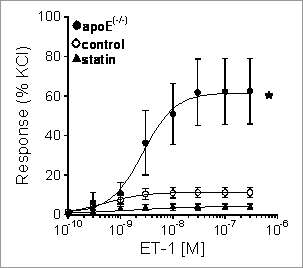Print version
Search Pub Med
Atorvastatin treatment reverses increased vasoconstrictor responses to endothelin-1 in apolipoprotein E(-/-) mice Endothelin-1 (ET-1) causes heightened responses in aortic rings from the apolipoprotein E knockout (apoE(-/-)) mouse model of atherosclerosis compared to C57/BL6 mice (Wiley et al, 2003), consistent with the observation of up-regulation of the ET system in human atherosclerosis (Maguire & Davenport, 1998). HMG-CoA reductase inhibitors such as atorvastatin reduce low density lipoprotein-cholesterol and decrease coronary events by slowing progression of atherosclerosis. Our aim was to determine if treatment with atorvastatin modified the augmented response to ET-1 in aortae of apoE(-/-) mice. 14-24 week C57/BL6 (control) and apoE(-/-) mice (either sex, 25-35g; Charles River, UK) were used in this study. The statin treated apoE(-/-) group received atorvastatin 30mg/kg/day via oral gavage for 6 weeks. Rings of aorta (1-2mm) were mounted in wire myographs (in oxygenated Krebs’ solution at 37°C) and isometric tension recordings were made following the additions of cumulative concentrations of ET-1 (0.1-300nM). Concentration-response curves (CRC) were expressed as a percentage of the response to 95mM KCl (mean ± s.e.mean) and data analysed using the curve fitting programme FigP (Biosoft, Cambridge, UK) to determine values of potency (pD2) and maximum response (EMAX). We also determined whether atorvastatin (10µM) competed for 125I-ET-1 (0.1nM) binding in cryostat sections of heart. Figure 1. Cumulative CRC to ET-1 in C57/BL6 (control, n=5) and apoE(-/-) (n=5) and statin treated apoE(-/-)(n=5) mouse aorta in vitro (*P<0.05, ANOVA).
The maximum constrictor response to ET-1 was significantly higher in apoE(-/-) mouse aorta than in controls (Figure 1: Control - EMAX 11.0 ± 2.63%, n = 5; ApoE(-/-) -EMAX 58.8 ± 21%, n=5; P<0.05, ANOVA). The maximum ET-1 responses in the apoE (-/-) group treated with atorvastatin (EMAX 3.99 ± 1.47%, n=5) were not significantly different from control (P>0.05, ANOVA). There was no difference in potency of ET-1 between the three groups (Control pD2 9.3 ± 0.16; ApoE(-/-) pD2 8.7 ± 0.13; Statin pD 2 9.1 ± 0.15, P>0.05 ANOVA). Atorvastatin (10 µM) did not compete for 125I- ET-1 binding to heart tissue (n=3). These data demonstrate that atorvastatin treatment prevents the increased vasoconstrictor response to ET-1 in the apoE(-/-) mouse model of atherosclerosis that was not due to a direct effect of atorvastatin on the ET receptor. This protective effect, in addition to their lipid lowering properties, may contribute to the therapeutic actions of statins in human cardiovascular disease. Maguire, J.J. & Davenport, A.P. (1998). Br. J. Pharmacol., 125(2), 238-240. |


